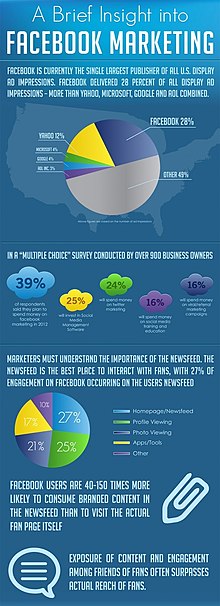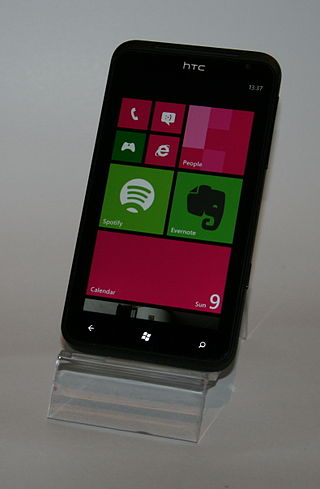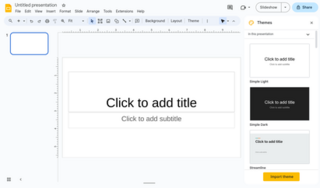This article has multiple issues. Please help improve it or discuss these issues on the talk page . (Learn how and when to remove these template messages)
|
This article has multiple issues. Please help improve it or discuss these issues on the talk page . (Learn how and when to remove these template messages)
|
Dark social media, dark social, or dark traffic are terms coined by the online marketing and advertising community to refer to social sharing of URLs that do not contain any digital referral (i.e. tracking) information about the source. [1] [2] The concept of a "dark" link is generally used by people working in web analytics as well as in online advertising, who have come to expect that they will be able to monitor and profile website visitors and app users, sometimes in quite controversial ways such as mouse tracking to follow people's activities by tracking their mouse movements.
Privacy advocates would typically refer to a URL without tracking information as a clean URL, i.e. one which simply takes the user to the requested web page or resource. Some technology providers have made these privacy-enhancing technologies a particular focus of their operating system [3] and web browser applications. [4] Legislation such as the European Union's General Data Protection Regulation and Digital Markets Act specifically targets this surveillance capitalism approach to providing Internet products and services.
In contrary to the sharing on social networking service like Facebook, which is done publicly, Dark social is done privately through IRC channels, emails, SMS or simply copy-and-paste and other ways of private sharing. [1] [5] Not to confuse with deep web, dark social media is not about the content but the traffic of online sharing. [5] These sharing activities will often come up under the name of direct, typed/bookmarked or other similar form in today's web analytic services. [6] [5] And in 2014, it is believed that Dark Social consisted of 69% of sharing activities globally, whereas Facebook only holds 23%. [7]
However, the exact nature of dark social media is still unknown, as the word "dark" in the name itself suggests that unknown or can't-see is in the heart of the concept like dark energy in astronomy. [5]
Alexis Madrigal was curious about where traffic was really coming from for the site that he worked for, The Atlantic . He grew up in a time when the web was just being built and knew there were other ways to share information, not just through big name sites like Facebook. This led him to believe that a large portion of web traffic was not coming from "bookmarked" or "typed in" sources as he was being led to believe. With the help of web analytics firm, Chartbeat, he was able to quantify this traffic into something much more meaningful. The article that he then wrote brought about the usage of the term Dark Social. [5]
Dark social has also been known as direct social [5] or dark traffic. [2] However, Alexis Madrigal's term "Dark Social" became the most widely used in the online marketing community. [7]
Dark social media can be perceived differently when looking at desktop computers vs mobile computers. In 2014, almost 50% of the total external mobile traffic was Dark Social traffic, meaning that the traffic did not have a referrer showing where they were coming from. In contrast, only one-third of the external desktop traffic was from Dark Social. [1]
In 2014, two years after Alexis Madrigal wrote the original post about dark social, [5] he started to notice that dark social traffic could come from mobile devices as well. Madrigal mentioned that since October 2015, Facebook had changed their algorithm for the mobile app, which resulted in the media publisher receiving over 100% more traffic than before. In the meantime, he has also noticed the Atlantic, the company he used to work for, received a lot of dark social traffic, which was not the Facebook mobile traffic. [8]
Alexis Madrigal later performed an experiment to confirm his theory that the dark social traffic boost was indeed from Facebook mobile app. He found that the referrer links from Facebook’s mobile app don't always pass to the destination website, which creates Dark Social traffic for mobile devices. [8] An updated Charbeat report also confirmed that part of the Dark Social traffic was generated by Facebook mobile app and its own users. [1] In addition to Facebook mobile app, dark social traffic can also come from Reddit mobile app, Gmail and Instant messaging apps as well. [9]
In one of RadiumOne's report published in February 2016, the dark side of mobile sharing, the company stated they have found that 84% of the online traffic is coming from Dark Social channels to date. Furthermore, they also showed that out of all the Dark Social traffic, 62% are from mobile devices, while only 38% are from desktops. The rise of smart phones and mobile apps had largely increased the Dark Social traffic on mobile devices over the last few years. The amount of Dark Social traffic from mobile devices jumps from 53% in 2014 to 62% in 2016, while the Dark Social traffic that comes from desktops decreases from 47% in 2014 to 38% in 2016. [10]
Dark social traffic consists mostly of one-to-one messaging through non-dark channels such as Facebook Messenger and Snapchat rather than more commonly used one-to-many methods; for example, sharing to a Twitter feed, or Facebook wall, which traditional analytics tools rely upon. [11] Links shared through private messaging methods may not include referral tags and to an analytics tool, they can simply appear as though they came through direct traffic or could include referral tags copy and pasted from another non-dark social channel. [12]

Because the referral tags are not always carried over through private messaging, it becomes impossible to tell if a person sharing through dark traffic had originally obtained the content through another referral method or directly copy-pasting the link. This makes it difficult for marketers to understand how effective their social media marketing strategy is and make changes accordingly.
To combat this lack of transparency, websites can include more attractive ways to share links than simply copy-pasting into another application; for example, sites can implement highly visible share buttons, a copy-paste button, or buttons to share a link with a referral tag directly to a dark social channel like WhatsApp, Facebook Messenger, or email. Rules can also be made within traditional analytics tools to filter out dark social traffic that can include direct links, but exclude those that weren't referred from the homepage. [13] Analytics tools are also beginning to incorporate the ability to distinguish between dark social copy-paste based traffic and other types of traffic. [14]
The invisible web is also known as the deep web. Where dark social is referring to web traffic that cannot be analyzed, [7] invisible web is referring to websites and data that are not indexed in search engines. [15] In essence, both kinds of information are invisible to the general population on the Internet. Dark social data cannot be found by web analytics software to see where traffic originates from [5] and invisible web data will not show when using search engines like Google Search or Microsoft Bing. [15] Both of these hidden results are unintentional. The dark web is associated with Dark social and invisible web, but mainly because of its hidden nature. Dark web data is data that is intentionally hidden on the Internet because those involved wish to remain anonymous. [15]
There is interest in who shares content and how they share it. The psychology of dark social sharing has found that people share for three reasons. [16]
1. Identity and context
Dark social sharing allows for individualism as people are able to freely express themselves in choosing what- and with whom- to share rather than broadcasting everything to all their "friends".
2. Relationship building
Dark social sharing creates a "personal" channel where sharing elevates and builds personal relationships, even defying geographical boundaries.
3. Social currency
Dark Social sharing allows for people to feel helpful, on trend, or interesting. When sharing to a smaller, intimate social circle, the sharer gets to be knowledgeable within their groups, giving them street cred.
Email and IM are the common sources of dark social sharing but Facebook may actually be the part of the cause of the increase in dark social-through their chatting and messaging services. [17] Other sources of Dark Social are Reddit, StumbleUpon, Twitter, Tumblr, LinkedIn and Google+, WhatsApp, Viber, Kwik, Firechat, OM and Livetext. [18] There is some evidence by Pew [19] research that age accounts for who is sharing darkly and those sharing by means that can be tracked easier. Baby Boomers (born between 1946 and 1964) and Gen Xers (born between 1965 and 1981) commonly share by email and word of mouth. In fact, Gen Xers are the heaviest users of email, which is considered dark social. Millennials (born 1982–1995) and younger tend toward social media and sharing through these applications, often reported as dark. In addition, sharing professionally and darkly, as on LinkedIn, requires upwards of 15 hours a week to have an impact. Certain platforms also attract other types of populations such as blogs with the LGBT community. [18]

Microsoft Outlook is a personal information manager software system from Microsoft, available as a part of the Microsoft 365 software suites. Though primarily being popular as an email client for businesses, Outlook also includes functions such as calendaring, task managing, contact managing, note-taking, journal logging, web browsing, and RSS news aggregation.
An application program is a computer program designed to carry out a specific task other than one relating to the operation of the computer itself, typically to be used by end-users. Word processors, media players, and accounting software are examples. The collective noun "application software" refers to all applications collectively. The other principal classifications of software are system software, relating to the operation of the computer, and utility software ("utilities").

Google Analytics is a web analytics service offered by Google that tracks and reports website traffic and also the mobile app traffic & events, currently as a platform inside the Google Marketing Platform brand. Google launched the service in November 2005 after acquiring Urchin.

Bing for mobile is a search tool for handheld mobile devices from Microsoft as part of their Bing search engine. It is designed for mobile device displays. Bing Mobile is built into Windows Mobile and Windows Phone as proprietary software, accessed via the Search key on Windows Phone 7 and Windows Phone 8 devices. It is also available on Windows Phone 8.1, and can be downloaded for other platforms, including and Android.

Digital marketing is the component of marketing that uses the Internet and online-based digital technologies such as desktop computers, mobile phones, and other digital media and platforms to promote products and services. Its development during the 1990s and 2000s changed the way brands and businesses use technology for marketing. As digital platforms became increasingly incorporated into marketing plans and everyday life, and as people increasingly used digital devices instead of visiting physical shops, digital marketing campaigns have become prevalent, employing combinations of search engine optimization (SEO), search engine marketing (SEM), content marketing, influencer marketing, content automation, campaign marketing, data-driven marketing, e-commerce marketing, social media marketing, social media optimization, e-mail direct marketing, display advertising, e-books, and optical disks and games have become commonplace. Digital marketing extends to non-Internet channels that provide digital media, such as television, mobile phones, callbacks, and on-hold mobile ringtones. The extension to non-Internet channels differentiates digital marketing from online marketing.
Mobile web analytics studies the behaviour of mobile website users in a similar way to traditional web analytics. In a commercial context, mobile web analytics refers to the data collected from the users who access a website from a mobile phone. It helps to determine which aspects of the website work best for mobile traffic and which mobile marketing campaigns work best for the business, including mobile advertising, mobile search marketing, text campaigns, and desktop promotion of mobile sites and services.
MobileMe is a discontinued subscription-based collection of online services and software offered by Apple Inc. All services were gradually transitioned to and eventually replaced by the free iCloud, and MobileMe ceased on June 30, 2012, with transfers to iCloud being available until July 31, 2012, or data being available for download until that date, when the site finally closed completely. On that date all data was deleted, and email addresses of accounts not transferred to iCloud were marked as unused.
A software widget is a relatively simple and easy-to-use software application or component made for one or more different software platforms.
SEVEN Networks, Inc. is a privately funded American corporation founded in 2000. It had about 265 employees in 2010. As of 2017, the company has research and development centers in Texas and Finland.
Mobile Business Intelligence is defined as “Mobile BI is a system comprising both technical and organizational elements that present historical and/or real-time information to its users for analysis on mobile devices such as smartphones and tablets, to enable effective decision-making and management support, for the overall purpose of increasing firm performance.”. Business intelligence (BI) refers to computer-based techniques used in spotting, digging-out, and analyzing business data, such as sales revenue by products and/or departments or associated costs and incomes.
A mobile application or app is a computer program or software application designed to run on a mobile device such as a phone, tablet, or watch. Mobile applications often stand in contrast to desktop applications which are designed to run on desktop computers, and web applications which run in mobile web browsers rather than directly on the mobile device.

Windows Phone 7 is the first release of the Windows Phone mobile client operating system, released worldwide on October 21, 2010, and in the United States on November 8, 2010. It runs on the Windows CE 6.0 kernel.

Google Slides is a presentation program included as part of the free, web-based Google Docs suite offered by Google. Google Slides is available as a web application, mobile app for: Android, iOS, and as a desktop application on Google's ChromeOS. The app is compatible with Microsoft PowerPoint file formats. The app allows users to create and edit files online while collaborating with other users in real-time. Edits are tracked by a user with a revision history presenting changes. An editor's position is highlighted with an editor-specific color and cursor and a permissions system regulates what users can do. Updates have introduced features using machine learning, including "Explore", offering and "tasks to other users."

Google Sheets is a spreadsheet application included as part of the free, web-based Google Docs Editors suite offered by Google. Google Sheets is available as a web application; a mobile app for: Android, iOS, and as a desktop application on Google's ChromeOS. The app is compatible with Microsoft Excel file formats. The app allows users to create and edit files online while collaborating with other users in real-time. Edits are tracked by which user made them, along with a revision history. Where an editor is making changes is highlighted with an editor-specific color and cursor. A permissions system regulates what users can do. Updates have introduced features that use machine learning, including "Explore", which offers answers based on natural language questions in the spreadsheet. Sheets is one of the services provided by Google that also includes Google Docs, Google Slides, Google Drawings, Google Forms, Google Sites and Google Keep.
Yookos is an online social networking service founded in 2011 by the leader of Christ Embassy International. It was initially used by church members, but later the site was expanded to allow public access. The site received more than half of its traffic from Nigeria and the remaining user base was from Zimbabwe, South Africa, the UK and the US.
Onavo, Inc. was an Israeli mobile web analytics company owned by Facebook, Inc.. The company primarily performed its activities via consumer mobile apps, including the virtual private network (VPN) service Onavo Protect, which analysed web traffic sent through the VPN to provide statistics on the usage of other apps.

Google Docs is an online word processor included as part of the free, web-based Google Docs Editors suite offered by Google, which also includes Google Sheets, Google Slides, Google Drawings, Google Forms, Google Sites and Google Keep. Google Docs is accessible via an internet browser as a web-based application and is also available as a mobile app on Android and iOS and as a desktop application on Google's ChromeOS.